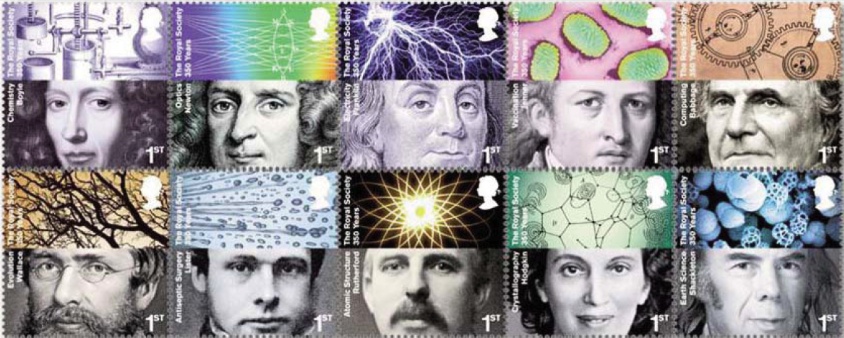

Robert
Boyle, Chemistry
Boyle (1627 – 1691)
was a natural philosopher, chemist, physicist, inventor, and gentleman
scientist, also noted for his writings in theology. He is best known
for the formulation of Boyle’s Law. Although his research and
personal philosophy clearly has its roots in the alchemical tradition,
he is largely regarded today as the first modern chemist, and therefore
one of the founders of modern chemistry. Among his works, The
Sceptical Chymist
is seen as a cornerstone book in the field of chemistry.
Sir
Isaac Newton, Optics
Newton (1643 –1727)
was an English physicist, mathematician, astronomer, natural
philosopher, alchemist, and theologian who is perceived and considered
by many as one of the most influential men in history. His Philosophiæ
Naturalis
Principia Mathematica,
published in 1687, is by itself considered to be among the most
influential books in the history of science, laying the groundwork for
most of classical mechanics. In this work, Newton described universal
gravitation and the three laws of motion which dominated the scientific
view of the physical universe for the next three centuries. Newton was
also president of The Royal Society. The 300th anniversary
of Principia
Mathematica was marked by a
set of four stamps in 1987.
Benjamin Franklin, Electricity
Franklin (1706
–1790) was one of the Founding Fathers of the United States
of America. A noted polymath, Franklin was a leading author
and printer, satirist, political theorist, politician, scientist,
inventor, civic activist, statesman, soldier, and diplomat. As a
scientist, he was a major figure in the Enlightenment and the history
of physics for his discoveries and theories regarding electricity. He
was important in the development of scientific experimentation and
invented the lightning rod, bifocals, the Franklin stove, a carriage
odometer, and the glass 'armonica'. Franklin appeared on the
11p US Bicentenary stamp issued in 1976.
Edward Jenner, Vaccination
Jenner (17 May 1749 – 26 January 1823) is widely credited as
the pioneer of smallpox vaccine, and is sometimes referred to as the
‘Father of Immunology’. Jenner observed that
milkmaids rarely got smallpox and concluded that exposure to the bovine
disease cowpox conferred immunity a theory he tested and proved by
injecting a child with pus from cowpox blisters. Jenner's
development of the smallpox vaccine was marked by a 20p stamp in the
'Patients Tale' Millenium set in March 1999.
Charles
Babbage, Computing
Babbage, (1791 – 1871) was an English mathematician,
philosopher, inventor and mechanical engineer who originated the
concept of a programmable computer. Babbage was pictured on a
22p Scientific Achievements stamp in 1991.
Alfred
Russel Wallace, Evolution
Wallace (1823 – 1913) was a British naturalist, explorer,
geographer, anthropologist and biologist. He is best known for
independently proposing a theory of natural selection which prompted
the joint reading of his and Charles Darwin’s papers on
evolution in 1858, and spurred Darwin to publish his own theory the
following year.
Joseph
Lister, Antiseptic Surgery
Lister, 1st Baron Lister, (1827 – 1912) was an English
surgeon who promoted the idea of sterile surgery while working at the
Glasgow Royal Infirmary. He successfully introduced carbolic acid
(phenol) to sterilize surgical instruments and to clean wounds, which
led to reduced post-operative infections and made surgery safer for
patients. The centenary of Lister's discovery of Antispectic
Surgery was marked by two stamps issued in 1965.
Ernest
Rutherford, Atomic Structure
Rutherford, 1st Baron Rutherford of Nelson, (1871 – 1937) was
a New Zealand born chemist and physicist who became known as the father
of nuclear physics. He discovered that atoms have a small charged
nucleus, and thereby pioneered the Rutherford model (or planetary
model, which later evolved into the Bohr model or orbital model) of the
atom, through his discovery of Rutherford scattering with his gold foil
experiment. He was awarded the Nobel Prize in Chemistry in 1908. He is
widely credited as splitting the atom in 1917 and leading the first
experiment to ‘split the nucleus’ in a controlled
manner by two students under his direction, John Cockcroft and Ernest
Walton in 1932. He was also president of The Royal Society.
Dorothy
Hodgkin, Crystallography
The stamp marks the centenary of the birth of Dorothy Mary Hodgkin,
(1910 –1994). She was a British chemist, credited with the
development of Protein crystallography. She advanced the technique of
X-ray crystallography, a method used to determine the three dimensional
structures of biomolecules. Hodgkin was also the first female Briton to
win a Nobel Prize. Hodgkin was also featured on a 20p 'Famous
Women' stamp in 1998.
Sir
Nicholas Shackleton, Earth Sciences
Shackleton (1937 – 2006) was a British geologist and
climatologist who specialised in the Quaternary Period. Much of
Shackleton's later work helped to clarify the rates and mechanisms of
aspects of climate change - a fitting subject to bring the stamp set
right up to date.
The four panes of the PSB are shown here. Note that these are pre-issue mock-ups; the 54p Machin will have the same font as on the Classic Album Covers PSB.
|
Background shows aerial view of CERN in Switzerland and location of Large Hadron Collider. 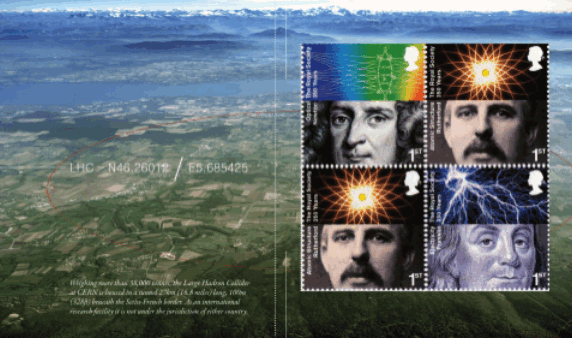
|
Centre label shows Coat of Arms of Royal Society, Background: Galaxy pair NGC 3334, image from NASA (Hubble) 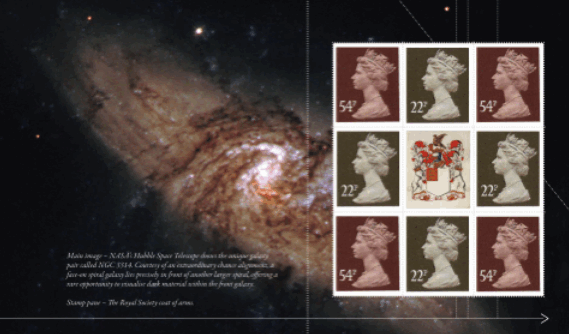 |
|
Pane 1 (below): Wallace, Boyle, Babbage & Shackleton. Background shows The Royal Society's website, and it's HTML code 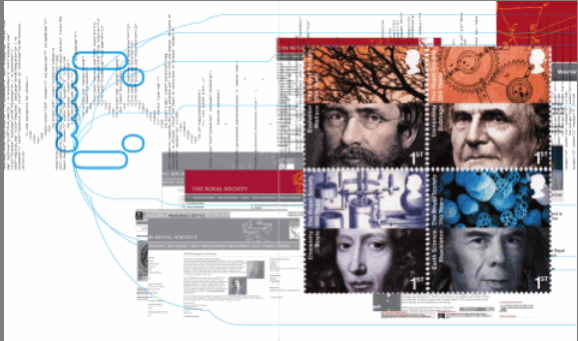 |
Pane 4 (below): Hodgkin, Jenner (2) & Lister Background: Harvesting casava plants, to assist the fight against disease. 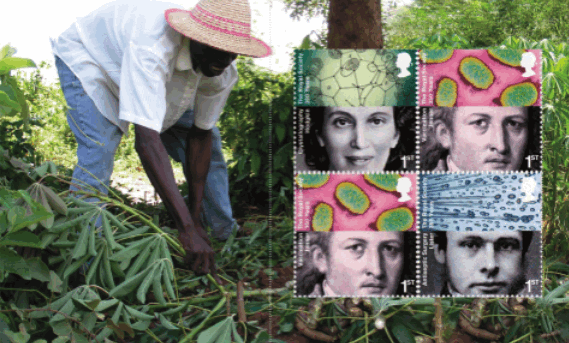 |
The stamps were designed by Hat-trick Design (see photo credits below), and are printed by Cartor Security Printing, the sheet stamps in gravure and the PSB litho. The 35mm square stamps are perf 14.5 in sheets of 30/60 with all over phosphor.
Image credits: Robert Boyle drawing and portrait, crystallography pattern © The Royal Society; colour spectrum, smallpox vaccination, Edward Jenner portrait, Ernest Rutherford portrait © Science Photo Library; Isaac Newton diagram and portrait, Charles Babbage diagram and portrait, Dorothy Hodgkin portrait © Science Museum/SSPL; lightning and Benjamin Franklin portrait © Getty Images; Alfred Russel Wallace portrait © National Portrait Gallery, London; oak tree photographed by Paul Grundy; Joseph Lister portrait © Wellcome Library, London; spray photographed by John Ross; atom © iStockphoto; micro-fossil image © SEPM Society for Sedimentary Geology, photographed by Dr Stanley A King; Nicholas Shackleton portrait courtesy of Ingrid Pearson
Products available:
Block of 10
stamps
First day cover -
Prestige stamp book
Presentation pack -
Stamp cards -
Special
Postmarks
Postmarks available for the day of
issue are shown here - others (if any) will be added when they are
published.
These postmarks cannot be obtained after the date of
issue. Not to scale.
|
|
|
|
|
|
|
Ref FD1007 |
Ref FD1008 |
Ref FD1008NP |
Ref L11619 Spring Stampex The Royal Society First Day of Issue, London N1 |
Ref L11629 Celebrating 350 Years of Excellence in Science The Royal Society, London SW1 |
|
|
|
|
|
|
|
Ref L11630 - Carlton House Terrace, London SW1 |
Ref L11631 - Cambridge |
Ref L11632 Gresham Street, London EC2 |
Ref L11633 - Hyde Park Corner, London SW1 |
Ref L11634 - London SW1 |
|
|
|
|
|
|
|
Ref L11635 Chemistry, Whitchurch |
Ref L11636 - Cambridge |
Ref M11644 Newton Road, Birmingham |
Ref L11640 London SW1 - "If I have seen further it is by standing on the shoulders of Giants" - Isaac Newton. |
Ref L11639 - Evolution Wallace Road London W1 |
If
you would like to be contacted
when this page is updated please sign up on the ChangeDetection panel
at the top of the page.
If you have any questions,
please email
us.
NB:
all emails will be
acknowledged in 1-2 days unless we are away (see home page). If you
do not receive an acknowledgement please email us from a different
address (eg hotmail, gmail).
This page updated 19 October 2010